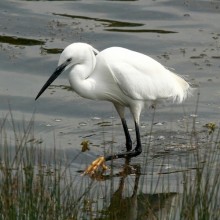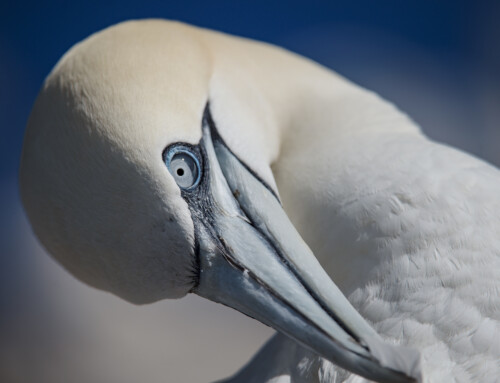
Little Egret © Graham Canny
A simple electivity index allows us to understand how habitat preferences vary between species and over time.
LINKED PAPER
Do birds of a feather flock together? Comparing habitat preferences of piscivorous waterbirds in a lowland river catchment. Wood, K. A. & Stillman, R. A. 2014. Hydrobiologia 738: 87-95.
DOI: 10.1007/s10750-014-1921-6
Our research is the first to quantify Little Egret (Egretta garzetta) habitat preferences within the recently colonised UK. More generally, we show how a simple electivity index, informed by the types of data routinely collected for bird populations, can be used to quantify and compare the habitat preferences of different species.
With their ability to fly great distances to find suitable habitat, birds have arguably the greatest ability of all animals to move into and exploit new areas outside of their native range in response to environmental change. In particular, many bird species have responded to climate change by shifting their range northwards (Hitch & Leberg, 2007; La Sorte & Thompson, 2007). One example of a bird species shifting its distribution is the Little Egret, a piscivorous bird which began to colonise southern England during the 1980s (Lock & Cook, 1998). The little egret has spread rapidly within the UK, and has now been seen as far north as Shetland. However, despite this well-documented spread, habitat use by little egrets within the UK, and how such patterns of habitat exploitation compare with native piscivores, remain unknown.
We wanted to examine how little egrets were using habitat within areas that had been recently colonised. Given the ecological and socio-economic consequences of fish-eating birds in aquatic ecosystems (e.g. Kennedy & Greer, 1988; Feunteun & Marion, 1994), it is vital to understand how species will exploit aquatic habitats as they spread into new regions in order to manage and conserve aquatic ecosystems. In our recently published article we examined the overlap in habitat preferences within a lowland river catchment between the little egret and two native species of piscivore, the Grey Heron (Ardea cinerea) and Great Cormorant (Phalacrocorax carbo). These species are three of the major piscivorous bird species found in lowland river catchments in the UK. The study system we focused on, the River Frome (Fig. 1) catchment in Dorset (southern England), is a mosaic of different habitat types, with the key available habitats for a waterbird being river, lake, ditch, pasture field, arable field and estuary (Wood et al., 2013). We carried out repeated surveys of the River Frome catchment in 2009 and 2010 between its headwaters at Maiden Newton and its estuary at Poole Harbour. Poole Harbour was among the first places in Britain that little egrets were seen and known to breed, and so is a key site for the little egrets (Lock & Cook, 1998). Our survey covered all habitat types within 500m of the main river channel. Throughout the length of the river catchment, we recorded the habitat type on which individuals of each species were observed.

For each month, for each of the habitat types we calculated Ivlev’s electivity index (s), taking into account the number of birds of each species using that habitat, and the total available area of that habitat:
s = ( a – b ) / ( a + b ),
where a was the percentage of the population using a given habitat and b is the habitat area as a percentage of the total available habitat area (Jacobs, 1974). Electivity values are a useful way of indicating relative habitat use by animals; values range between -1.0 (habitat never used) and +1.0 (habitat exclusively used), with 0.0 representing habitat used in proportion with its availability. A positive value indicated that a species had a preference for that habitat, whilst a negative value indicated that the species was avoiding that habitat. In another recent project, we used this approach to quantify Mute Swan (Cygnus olor) habitat preferences, and how such preferences were influenced by season and social grouping (Wood et al., 2013).
We found that all three bird species showed strong preferences for river habitat in all seasons, with the other available habitat types used as auxiliary feeding areas. This seasonal use of multiple habitat types was consistent with Little Egret habitat use within its native range further south in continental Europe (e.g. Kazantzidis & Goutner, 1996; Dimalexis et al., 1997; Lombardini et al., 2001). Within the River Frome catchment we found strong egret preference for aquatic habitats, such as river and lake habitat, compared with pasture and arable agricultural habitat. Indeed, the only season in which the egrets showed a preference for terrestrial habitat was in winter, when they showed a slight preference for the pasture fields which typically flood during this time. Even in winter, the egrets had a stronger preference for river habitat relative to pasture.
Little egrets showed greater shared habitat preferences with grey herons, the native species to which little egrets are most morphologically and functionally similar. We found no differences between egrets and herons in electivity for river, lake, ditch and pasture habitats. Egrets and cormorants exhibited no differences in electivity only for river and lake habitats. Given the continued northwards range expansion of the little egret (Lock & Cook, 1998), knowledge of their habitat preferences will aid in understanding their exploitation of newly-colonised landscapes. However, there is no evidence from the Wetland Bird Survey data that the arrival and subsequent colonisation of southern England by the little egret has had an effect on the grey heron, despite the similarities in their habitat preferences. Indeed, the UK grey heron population size has remained relatively constant over the period of little egret colonisation (Austin et al., 2014).
References
Austin, G.E., Read, W. J., Calbrade, N. A., Mellan, H. J., Musgrove, A. J., Skellorn, W., Hearn, R. D., Stroud, D. A., Wotton, S. R. & Holt, C. A. 2014. Waterbirds in the UK 2011/2012: the Wetland bird survey. BTO/RSPB/JNCC, Thetford. View
Dimalexis, A., Pyrovesti, M. & Sgardelis, S. 1997. Foraging ecology of the grey heron (Ardea cinerea), great egret (Ardea alba) and little egret (Egretta garzetta) in response to habitat, at 2 Greek wetlands. Colonial Waterbirds 20: 261–272. View
Feunteun, E. & Marion, L. 1994. Assessment of grey heron predation on fish communities: the case of the largest European colony. Hydrobiologia 279/280: 327–344. View
Hitch, A. T. & Leberg, P. L. 2007. Breeding distributions of North American bird species moving north as a result of climate change. Conservation Biology 21: 534–539. View
Jacobs, J. 1974. Quantitative measurements of food selection. A modification of the forage ratio and Ivlev’s electivity index. Oecologia 14: 413–417. View
Kazantzidis, S. & Goutner, V. 1996. Foraging ecology and conservation of feeding habitats of little egrets (Egretta garzetta) in the Axios River Delta, Macedonia, Greece. Colonial Waterbirds 19: 115–121. View
Kennedy, G. J. A. & Greer, J. E. 1988. Predation by cormorants Phalacrocorax carbo (L) on the salmonids populations of an Irish river. Aquaculture Research 19: 159–170. View
La Sorte, F. A. & Thompson, F. R. 2007. Poleward shifts in winter ranges of North American birds. Ecology 88: 1803–1812. View
Lock, L. & Cook, K. 1998. The little egret in Britain: a successful colonist. British Birds 95: 273–280. View
Lombardini, K., Bennetts, R.E. & Tourenq, C. 2001. Foraging success and foraging habitat use by cattle egrets and little egrets in the Camargue, France. Condor 103: 38–44. View
Wood, K. A., Stillman, R. A., Coombs, T., Mcdonald, C., Daunt, F., & O’Hare, M. T. 2013. The role of season and social grouping on habitat use by mute swans (Cygnus olor) in a lowland river catchment. Bird Study 60: 229-237. View
Wood, K. A. & Stillman, R. A. 2014. Do birds of a feather flock together? Comparing habitat preferences of piscivorous waterbirds in a lowland river catchment. Hydrobiologia 738: 87-95. View
If you want to write about your research in #theBOUblog, then please see here.




